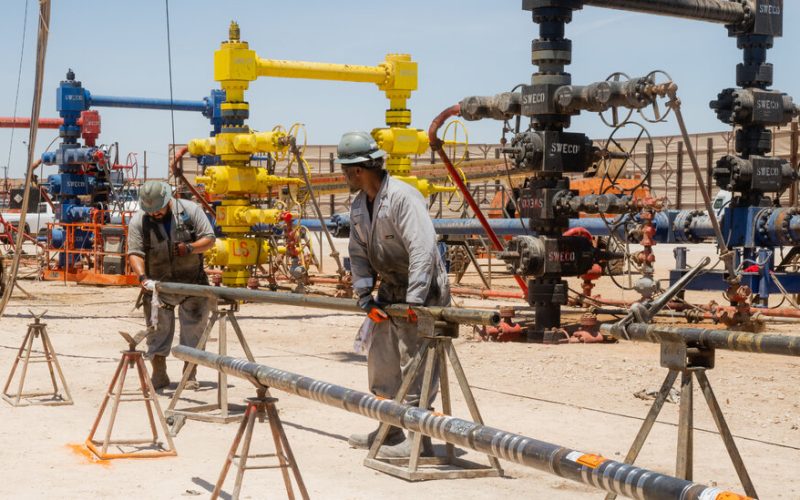President Trump has put unleashing American energy production at the center of his economic agenda, saying that ramping up fossil fuel production will lower inflation and end a cost of living crisis that has seen prices rise for staples like apples, bacon and eggs.
He declared a “national energy emergency” on Monday and said that high energy costs “devastate American consumers” by driving up the cost of transportation, heating, farming and manufacturing. Speaking to business leaders at the World Economic Forum in Davos on Thursday, the president renewed his pledge to unlock the “liquid gold” that the United States possesses.
But economists and analysts remain skeptical of Mr. Trump’s ability to influence energy costs — which are predominantly determined by global markets — and engineer an inflation cure-all.
“I don’t have the sense that the world is particularly short of fossil fuels in the present demand-and-supply balance,” said Howard Gruenspecht, a nonresident energy economist at the Center for Strategic and International Studies.
Expanding energy production is one pillar of an economic agenda that includes cutting taxes, increasing tariffs, rolling back regulations and reducing wasteful government spending. Mr. Trump this week also signed a separate executive order aimed at reducing housing and health care costs.
The president and his top economic officials have said this combination will usher in a “golden age” for the world’s largest economy, which has shown remarkable resilience in the aftermath of the worst inflation shock in a generation. Price pressures have eased significantly after peaking in 2022, all while the labor market has stayed strong.
One of the challenges is that Mr. Trump is creating an energy emergency that does not exist. The United States is already the world’s largest producer of oil and natural gas. The price of oil, about $76 per barrel, is in line with its average cost over the last two decades. Despite fears that war in Ukraine and the Middle East would cause gas prices to surge indefinitely, they have declined by about 3 percent, to about $3.13 per gallon, over the last year.
While Mr. Trump can create incentives for oil and gas companies to expand energy production, he cannot force them to produce. The oil and gas industry donated millions of dollars to Mr. Trump’s presidential campaign in hopes that he would roll back costly environmental regulations if elected. However, an expansion of production that drives down prices could also eat into the profits of big oil and gas companies.
Mr. Trump’s Treasury secretary nominee, Scott Bessent, has said that the United States should strive to increase domestic oil production, which is expected to average around 13.2 million barrels per day this year, by an additional three million barrels per day. That total could be more oil than the world can absorb.
The International Energy Agency, a multilateral organization based in Paris, is forecasting that global production will outpace demand by more than one million barrels a day this year.
Concerns about a looming glut have weighed on the price of oil, which has been hovering around $70 a barrel in the United States. U.S. companies generally need prices above $60 a barrel to profitably drill new wells, according to the Federal Reserve Bank of Dallas.
“It’s not a burdensome regulatory environment that’s holding back U.S. production,” said Helima Croft, a commodities analyst at RBC Capital Markets. “It’s because shareholders do not want these companies to drill themselves into unprofitability.”
Cheaper energy will not become a reality immediately, as new drilling projects can take years to bring online. In the meantime, some of Mr. Trump’s other plans could prove to be at odds with his ambitions to curb inflation.
Economists at Capital Economics noted that Mr. Trump’s planned tariffs on imports from Mexico and Canada could end up raising gas prices in the United States. About a quarter of the oil that is refined in the United States comes from Mexico and Canada, and oil refiners might end up passing higher costs from tariffs onto consumers. The economists added that Mr. Trump’s ambitions to develop Alaska’s energy resources could be thwarted by the high costs of developing and producing oil in the state.
“For all of Trump’s rhetoric and political theatrics, it’s important not to lose sight of the fact that he does not have as much power to deliver on his key pledges to boost U.S. fossil fuel production and exports and reduce energy prices as he might suggest,” they wrote in a research note on Thursday.
“Initially tariffs are a boost to inflation when they go into effect,” added Sarah House, a senior economist at Wells Fargo, who noted that the levies are also a drag on the broader economy. The price bump risks harming consumers as their “paycheck doesn’t go quite as far as a lot of the goods that they’re purchasing cost more.”
Wells Fargo raised its inflation forecasts for the year in anticipation of policy changes to be enacted by Mr. Trump. The bank’s economists do not expect the Federal Reserve, which has been trying to wrestle inflation back to its 2 percent target, to reach that goal until the latter half of 2026.
Much of the pain of inflation is currently being felt in the form of high interest rates on mortgages and other loans, and Mr. Trump will be under pressure to show progress on that front.
The Federal Reserve meets next week and is expected to pause a string of rate cuts that began in September as it assesses how quickly to ease its grip on the economy amid uncertainty about policy changes expected from the Trump administration.
But Mr. Trump made clear on Thursday that he expected his energy policies to translate into rate cuts.
“With oil prices going down, I’ll demand that interest rates drop immediately,” Mr. Trump said in remarks delivered remotely to the World Economic Forum in Davos. “And, likewise, they should be dropping all over the world. Interest rates should follow us.”
Jonathan Parker, an academic who serves as an economic adviser for the Congressional Budget Office, said the Fed can be “aggressive” with keeping interest rates high to “get ahead of any inflationary cycles unless they come from insolvency and fiscal repayment concerns.”
Bharat Ramamurti, who was deputy director of the National Economic Council in the Biden administration, suggested that Mr. Trump would find that increasing energy production is not a “silver bullet” to tame inflation.
“I think Trump is going to be grappling with the main issue that we faced in the White House too — that your tools for grappling with what is happening with inflation globally are pretty limited or pretty blunt,” Mr. Ramamurti said. “At the end of the day, it’s very hard to move the needle.”








